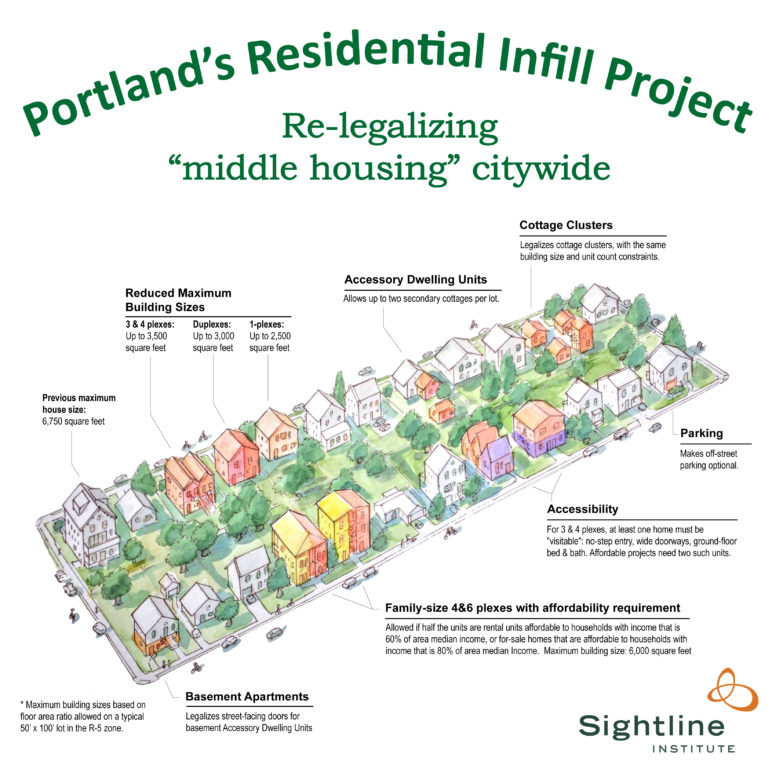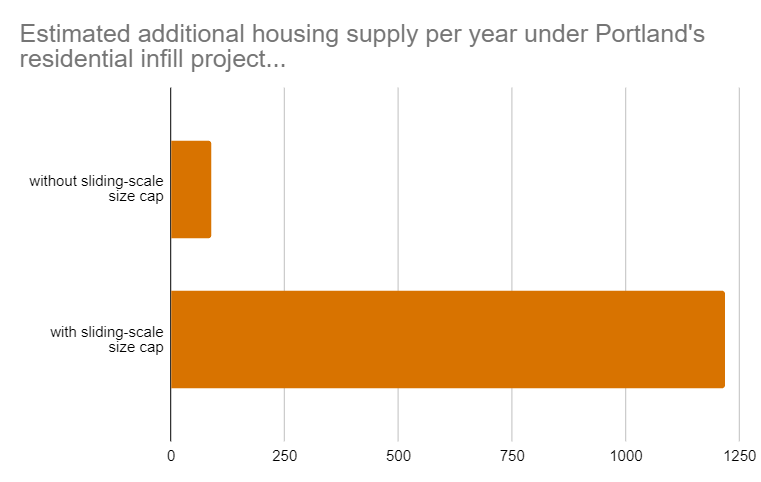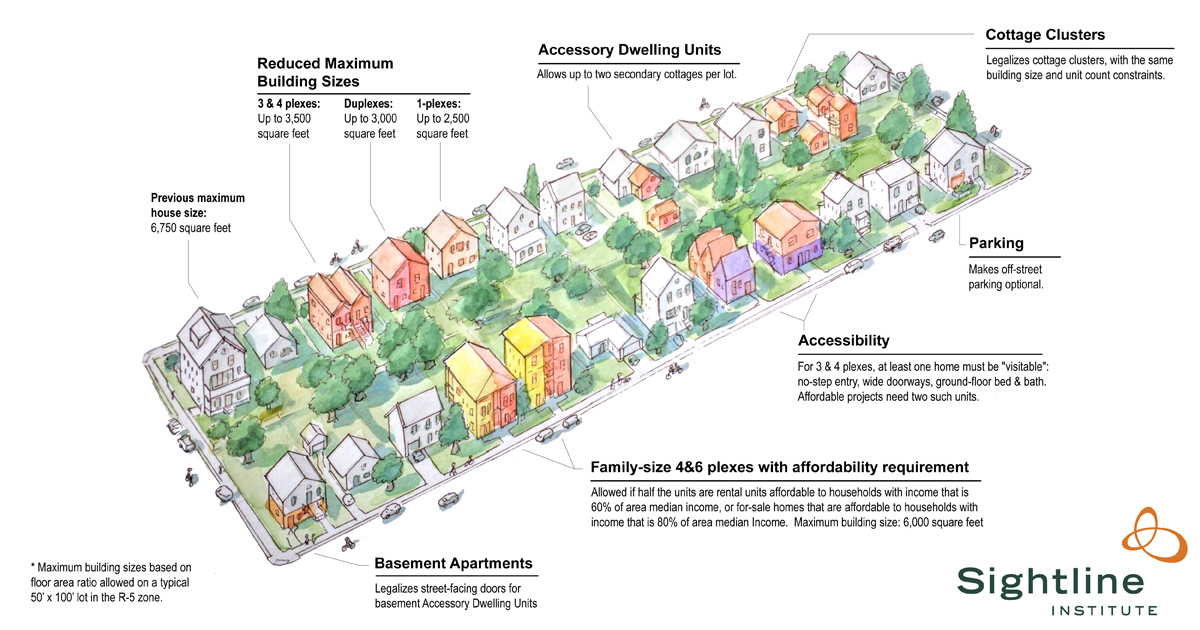Portland’s city council set a new bar for North American housing reform Wednesday by legalizing up to four homes on almost any residential lot.
Portland’s new rules will also offer a “deeper affordability” option: four to six homes on any lot if at least half are available to low-income Portlanders at regulated, affordable prices. The measure will make it viable for nonprofits to intersperse below-market housing anywhere in the city for the first time in a century.
And among other things it will remove all parking mandates from three quarters of the city’s residential land, combining with a recent reform of apartment zones to essentially make home driveways optional citywide for the first time since 1973.
It’s the most pro-housing reform to low-density zones in US history.
The “Residential Infill Project,” as it’s known, melds ideas pioneered recently by Minneapolis and Austin and goes well beyond the requirements of a state law Oregon passed last year.
The proposal passed 3-1. After years of local headlines describing the proposal as “controversial,” both of the council members up for re-election see their “yes” votes as key accomplishments. Of the council’s two open seats, a commissioner-elect and both candidates in Tuesday’s council runoff had also endorsed its principles.

Mayor Ted Wheeler, a business-oriented former Republican turned center-left Democrat, allied with two colleagues on his political left to pass the reform.
“Can’t wait to vote to get this thing implemented,” Commissioner Jo Ann Hardesty said last week, citing it as a step toward repairing what the city government now describes as its own history of “creating and enforcing racial segregation and inequities.”
“I’m ready to move forward,” Commissioner Chloe Eudaly agreed, after securing Wheeler’s support for a formal city effort to create a new “tenant opportunity to purchase” program when rental buildings are sold.
The one “no” vote was Commissioner Amanda Fritz, who first cut her political teeth fighting infill in her neighborhood in the early 1990s.
A snail’s-pace project that kept getting better

In the six years since the residential infill project’s concept was floated in a letter by a local micro-developer, Portland leaders have weighed and delayed it again and again, sending it back multiple times through the city’s wringer of public process.
But every time the plan was exposed to public opinion, it became more dramatic.
In 2016, the council unanimously agreed in concept to legalizing duplexes and corner triplexes in part of the city, plus a sharp restriction in building size. In 2018, after two epic public hearings, the plan shifted to allow up to four homes in any project, plus two crucial tweaks: an end to mandatory parking and extra size allowances for buildings that created more or cheaper homes. In 2019, Oregon’s legislature took up the issue, led by a former fourplex resident: Portland-based House Speaker Tina Kotek. That led to a groundbreaking state law legalizing “middle housing” of up to four homes throughout the Portland metro area, but stopping short of allowing it on any lot.
Early in 2020, Wheeler still couldn’t find the votes for the local reform—until another pair of hours-long hearings, in which pro-housing voices led by the advocacy groups Portland: Neighbors Welcome and Anti-Displacement PDX united around the concepts of adding the “deeper affordability” sixplex amendment and simultaneously pursuing other tenant protections like Eudaly’s “tenant opportunity to purchase” concept.
At those hearings, pro-housing testimony outnumbered anti-housing testimony more than six to one.
Throughout the process, the backers were a coalition of affordable housing developers like Hacienda Community Development, stable-housing advocates like the Cully Housing Action Team, environmentalists like Sunrise PDX, justice advocates like AARP Oregon, civic groups like the Northeast Coalition of Neighborhoods, transportation reformers like Oregon Walks, and dozens of active volunteers, with years of staffed organizing work by the anti-sprawl nonprofit 1000 Friends of Oregon and, later, us at Sightline.
“Who knew putting people at city council, testifying, writing letters and convincing their elected officials could change public policy?” Commissioner Hardesty said in June, admitting that until she’d heard from the public, even she had thought the sixplex concept was too radical to support.
This follows and surpasses reforms in other cities

Portland’s reform will build on similar actions in Vancouver and Minneapolis, whose leaders voted in 2018 to re-legalize duplexes and triplexes, respectively; in Seattle, where a 2019 reform to accessory cottages resulted in something very close to citywide triplex legalization; and in Austin, whose council passed a very similar sixplex-with-affordability proposal in 2019.
But Portland’s changes are likely to gradually result in more actual homes than any of those milestone reforms.
That’s because in both Vancouver and Minneapolis, city laws in low-density zones cap the size of new buildings no matter how many homes they create. In Minneapolis, for example, the interior square footage of a building can be up to half the square footage of its lot: 2,500 square feet of housing on a hypothetical 5,000 square foot lot.
Portland’s new rules set that same size limit for one-unit buildings. But Portland’s duplexes will be up to three-fifths the square footage of their lot, and triplexes and fourplexes up to 0.7.
The idea is for that extra square footage to work like a sluice gate for Portland’s housing market, rechanneling investment away from luxury remodels and McMansions and toward new homes that are affordable to the middle class on day one. Low-density parts of Vancouver and Minneapolis currently have no such distinctions.

As for Seattle, that city still bans new housing from the driveways of most primary homes, making infill geometrically impossible in many cases. Vancouver does, too.
Austin’s sixplex concept is a different matter. Splitting the fixed cost of a lot among even six homes doesn’t generally bring development prices low enough to be built without subsidy. So until Austin matches its excellent affordable-housing policy with a similar reform to market-rate housing, it’s tying its own hands behind its back.
Policies like this do, however, serve as a sort of force multiplier for nonprofits that are, like Habitat for Humanity, already developing modest homes at below-market prices.
As we wrote in January, legalizing sixplexes for regulated-affordable projects is the economic equivalent of cutting a check for $100,000 or more per affordable home. It alone may not be enough to make those homes appear, but it makes every existing subsidy go further. And it doesn’t take a dime away from other existing programs.
Just as importantly, it makes it feasible for builders like Habitat to gradually scatter such projects through all Portland neighborhoods. It lifts a de facto ban on new affordable housing from much of the city.
This is something every city should do – and federal governments should give them a reason to

It shouldn’t take six years for any city to agree to give itself permission to build the sort of homes that every city once allowed.
So-called “missing middle” housing options like triplexes, courtyard apartments and cottages aren’t radical or even unfamiliar. They’re just scarce—because they’ve been largely banned from cities across Cascadia and the rest of the US and Canada. In Portland, the bans began in 1924 and expanded almost citywide in 1959. Almost every city in either country that’s existed for more than a century has a similar story.
One effect, in many cities a primary goal, was to segregate people by class, race, age and income. But that wasn’t the only effect—bans on the lowest-cost way to create new homes accidentally created scarcity for everyone.
In the last few weeks, middle-housing bans unexpectedly became a high-profile issue in the US presidential race, as President Donald Trump cheerfully claimed responsibility for rising housing prices, applauding his administration’s flip-flop from saying exclusionary zoning is bad (because it drives up prices) to saying it is good (because those high prices preserve segregation).
The technical issue here, over enforcement of a provision of the Fair Housing Act of 1968, isn’t massively important to the number or price of homes that get built.
What matters more is a battle of big ideas. Is it good to have a diversity of housing types and prices in every neighborhood? Or is it bad?
In the last two years, the Democratic Party has rapidly come around to the position that it’s good. Its presidential candidate’s platform reflects this: Joe Biden says the federal government should withhold various grants from cities that don’t take steps toward the standard Portland is about to set.
It’s not clear which idea will win this new federal debate. There’s plenty of disagreement within both major US parties.
But it’s rarely been clearer than it is this week which side is winning right now.

